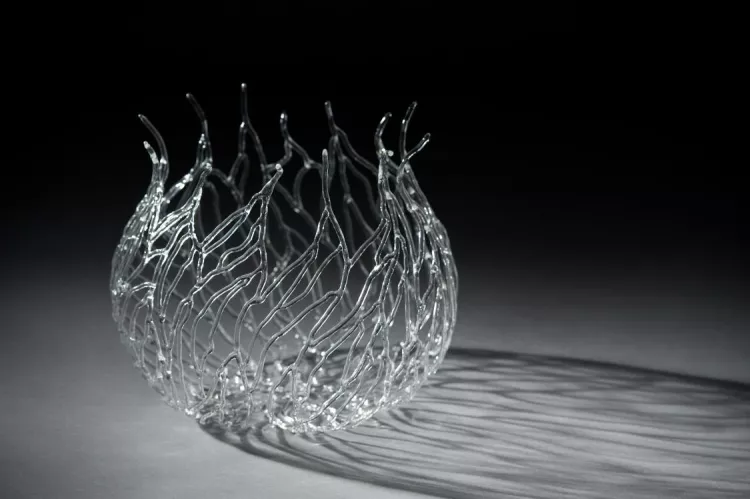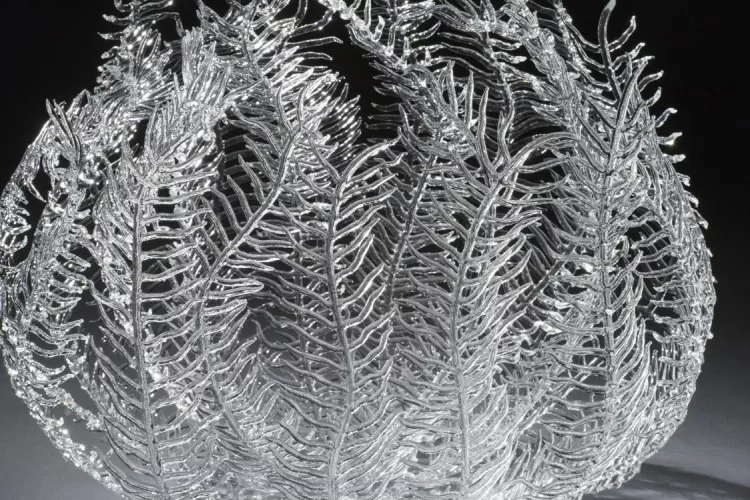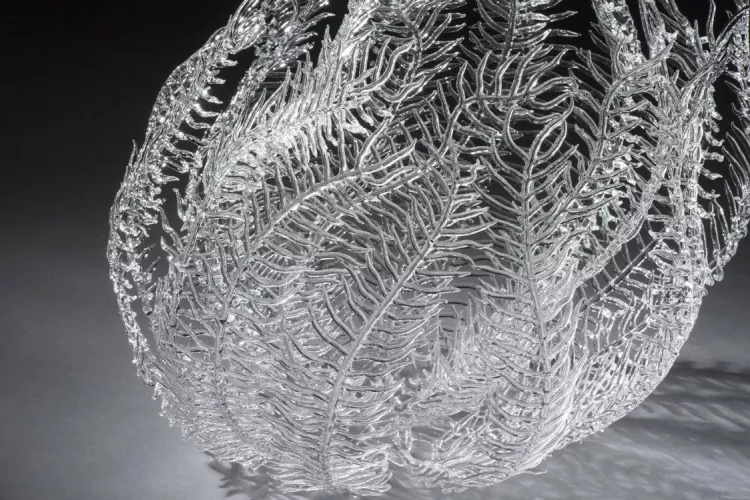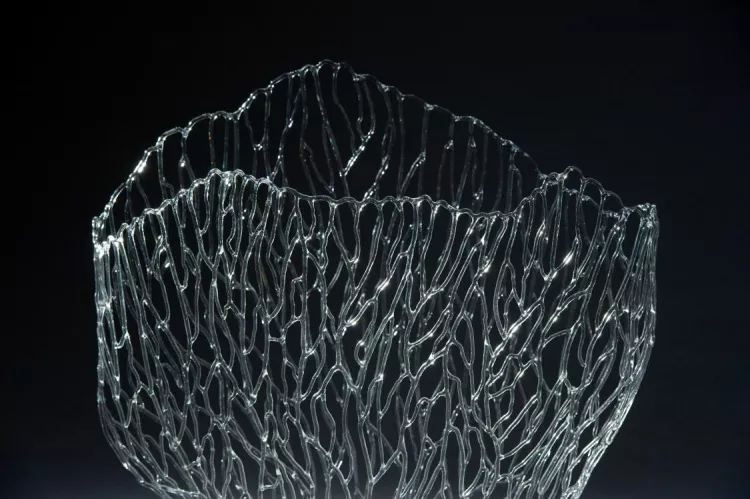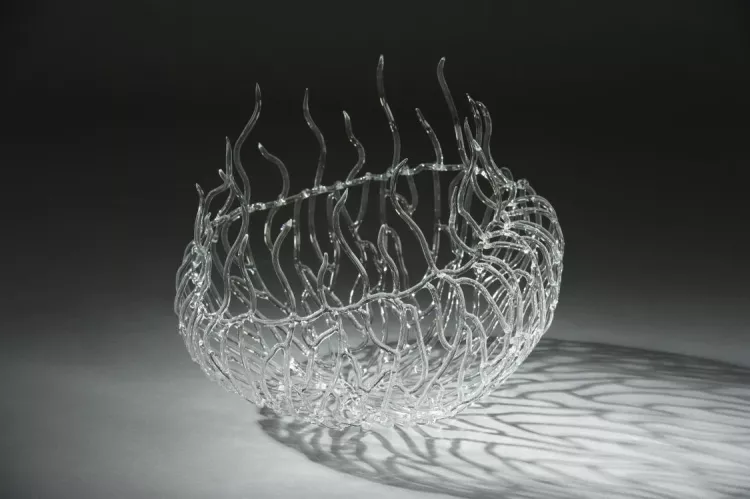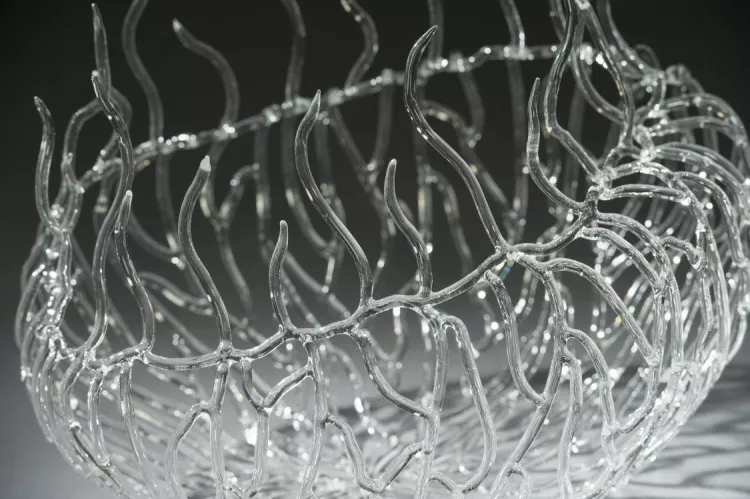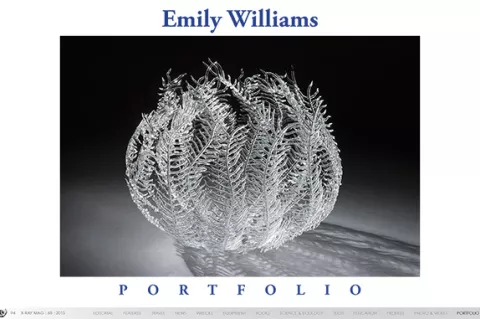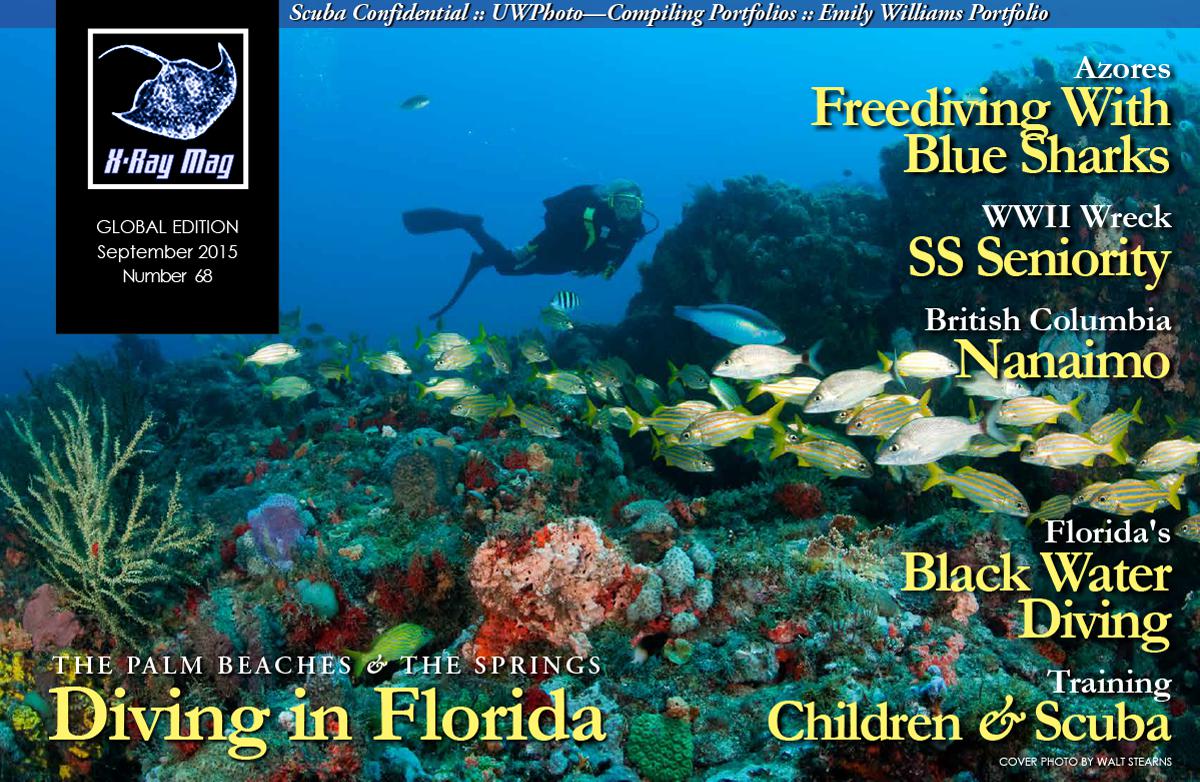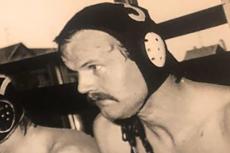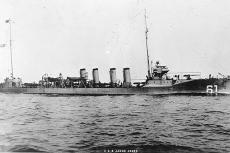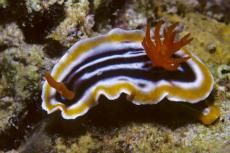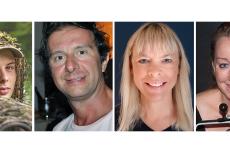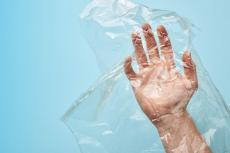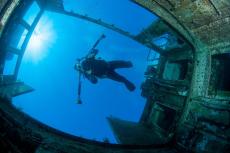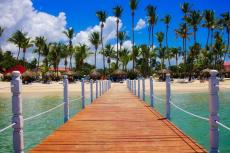
Emily Williams Portfolio
American artist Emily Williams creates delicate, intricate glass sculptures inspired by complex forms found in nature, including the sublime structures of corals and marine life as well as the dynamic shapes that water itself can take.
Contributed by
X-RAY MAG: Tell us about yourself, your background and how you became an artist.
EW: I can remember my first painting from when I was about four years old. All through my years, I can remember every single thing I ever created as a child.
I was very lucky because my father was an artist and also a neuroradiologist. He could make drawings, paintings, glass sculptures, architectural design, and sculptures of the brain. I watched him, from an early age, make wonderful paintings of water scenes from around Reedville and Tidewater, Virginia. I often became involved in his projects.
My father spent his whole life growing up around the Chesapeake Bay and Reedville in Virginia. So growing up, that was where we spent a lot of time. We always lived on the coast, whether it was Tidewater, Virginia; Huntington Beach, California; or on Mobile Bay, Alabama.
Being on the water is just a part of my soul, really. I especially loved the swamp environment of Alligator Bayou on Dog River in Mobile, Alabama. My parents lived on Alligator Bayou in Mobile County for 20 years. Some of the alligators could be really huge! Dog River gets its name from the alligators because they bark at night. I would like to live in a swamp again.
My parents always encouraged me to pursue art. I attended Virginia Commonwealth University and received my Bachelor of Fine Arts Degree in Sculpture. I then pursued my Master of Fine Arts Degree in Sculpture at Washington University in Saint Louis, Missouri. I had so many great professors in my life, so that also encouraged me to pursue sculpture. I think some people are just wired to be visual creators. Sculpture is all I have ever wanted to do in life.
X-RAY MAG: Why coral and underwater lifeforms? How did you come to these themes and how did you develop your style of glass sculpture?
EW: I think corals are just some of the most beautiful things on earth. I am awe-inspired by the variety of different species. Even within each species, there are still so many variants! I especially love the different patterns such as the meandering patterns of brain coral. I am intrigued with the whole idea of the “open” coral. This transforms a coral into a hairy mound!
While I currently work in transparent glass, I have a lot of plans to explore color in future sculptures. I am especially interested in exploring the brilliant, bioluminescent colors found in many corals.
I have always been a little frustrated by the opacity of so many sculptural materials. I want to play with light and luminosity. There is something magical and transformative to the spirit when viewing transparent glass. When I first began working with glass, I was doing cast glass and pate de verre. But I found the long, drawn-out processes of mold-making too time-consuming. I wanted a glass-working process that gave me instant results. The flameworking process allows me to create forms directly in glass using a hand torch.
I have a wild imagination for things in sculpture. Once I mastered the glass hand torch and kiln annealing cycles, I could easily imagine the potential. Clear borosilicate is so beautiful! It looks a lot like water. I have always loved the patterns, textures and colors of different oceanic lifeforms.
One of the first pieces I made was Coral Skeleton. This sculpture was inspired by the intricate patterns found in fan coral. I am also interested in a lot of plant forms, so I am particularly drawn to sealife that resembles plant forms such as seaweed, anemones and feather stars.
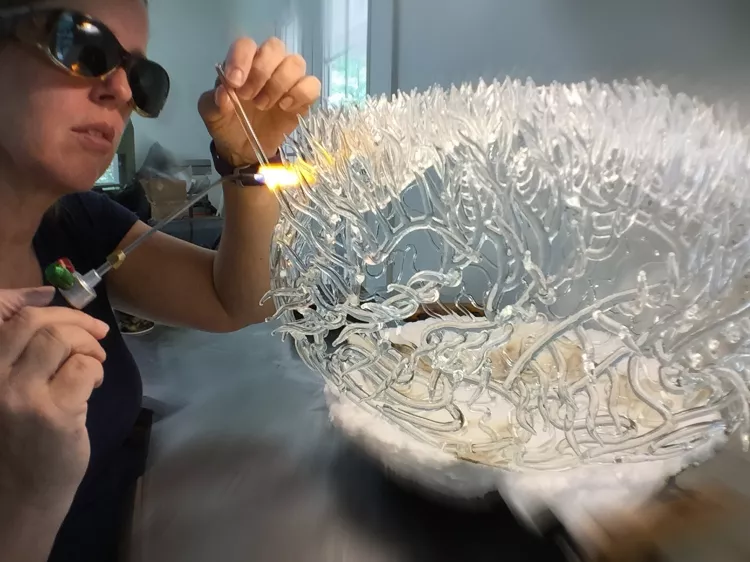
X-RAY MAG: What is your artistic method or creative process? How do you create your artworks?
EW: I use a special type of glass called “borosilicate” glass. People use boro every day in their life. It’s also called Pyrex. This type of glass is used for chemistry lab ware and also in the technology sector for fiber optic cables. Most people just know it as the kitchen glass!
I use a small hand-held glass torch to construct free form sculpture. So yes, I think that it is definitely considered a special glass technique in the glass world. Most flameworkers use a large, single bench torch. I, on the other hand, use a very un-macho mini-torch.
My glass is shipped to me in 25 lb cases of four-foot glass rods. I have many cases of glass rods in my studio covering diameters from 3mm to 12mm.
The first thing I determine is the size of the sculpture, and the size and diameter of rods that will best express the lifeform. Right now, I am very interested in several coral species.
The way I begin a piece is usually months and sometimes years in advance. I begin by collecting dozens of macro photographs and historical scientific illustrations about a particular creature. Ideally, I would prefer to view the species in real life. Often, I begin by trolling through the images until one strikes a chord. It can be a combination of things that draws me to a particular creature. I might be fascinated with the movement, textures and the color patterns.
An image or a series of images can help me visualize a sculpture. I then create enlargements of macro images and illustrations. These will be mounted on the wall near my glass bench.
Before beginning a large work, I always create test studies in glass. This way I can test out my ideas about how to build a particular form in glass. I then run the small test sculpture through the glass kiln annealing process. In all of the sculptures I create, I anneal the glass periodically to remove the stresses that build up.
Just like a drawing on paper, I begin with the prominent contours and structures of a form. For example, in the Glass Seaweed sculpture, I built the entire length of frond stems from the base upwards. Then I added temporary glass supports around the top edge to hold everything in place. Using supports keeps everything stable while working.
I then began at the very base joints adding all the seaweed tendrils, one by one. I gradually moved around the form in an upward spiral motion. This can take many weeks to complete. The luminous splendor of the Glass Seaweed sculpture comes from this intense focus and dedication of time.
I only work on one piece at a time, but while I work, I am already building new sculptures in my mind. For months, I have been installing new glass torches and stockpiling transparent colored glass for new coral sculptures.
X-RAY MAG: What is your relationship to the underwater world and coral reefs? Are you a scuba diver or snorkeler, and how has this influenced your art?
EW: I have always loved being in and around the water. Most of my experiences with the underwater world were on the Chesapeake Bay with jellyfish and crabs. When I was a child, we moved to southern California. My favorite experiences were on the Pacific Ocean. I loved exploring coastal caves, tidal pools, capturing sea potatoes or swimming in a kelp forest. Some of the areas around Catalina Island are just amazing.
I have never learned to scuba dive but have done some snorkeling in the Florida Keys. This past year, I thought I would like to take some scuba classes so I could visit and learn firsthand about Gray’s Reef off the state of Georgia’s coast.
X-RAY MAG: What are your thoughts on conservation of sea and freshwater environments and how does your artwork relate to these issues?
EW: I think anything that gets people to think about our oceans and waterways is a great thing. Art has a way of breaking through to a lot of people. It’s a nonverbal way of expressing really important ideas.
Of course, interpretation is personalized but I think glass is a pretty powerful metaphor for expressing the fragile nature of our natural world. Handle it with care… I try to be positive in my outlook but there is plenty to worry about in regard to our planet, global warming and the potential harm to so many creatures that live in our waters.
There are many things that communities and industry can do to help conserve ocean habitats such as coral reefs. I was just reading an article by Coral Morphologic about how rare elkhorn coral is being dredged around Miami. I find it amazing that the government is actually dredging out rare coral reefs around a major city in a hurricane zone. The sediment is very damaging to the entire area. So yes, I really care about all the creatures in the ocean from the whales to the sharks to the plankton.
X-RAY MAG: What is the message or experience you want viewers of your artwork to have or understand?
EW: I want people to walk away with a sense of wonder and marvel at the beauty of our ocean world. There is a bit of satire in my work, too. It is a serious, caring type of satire. While Leopold and Rudolf Blaschka documented so many species in their 19th century glass invertebrate models, let’s not let my work be the cataloging of their demise. It has only been about 100 years since the Blaschkas set out to make their glass models.
We may see a significant decline and extinction of many coral reefs in the next 25 years. I think most people are just completely unaware. Bringing about awareness is the start. I would love to be involved with a project that uses my glass art to bring more awareness to reef conservation. Not because it’s a good, valuable resource to local economies, but because it’s the right thing to do.
Cornell University has a very impressive collection of marine invertebrate glass models seen here at http://blaschkagallery.mannlib.cornell.edu/ [ed.— See X-RAY MAG issue #30 for our article on Blaschka glass here: http://www.xray-mag.com/pdfs/articles/Portfolio_Blaschka_30.pdf]
X-RAY MAG: What are the challenges and/or benefits of being an artist in the world today?
EW: One challenge is that you have to be an expert at so many things. I do all my own marketing, social media, web design, video, and run my studio. Recently, my work was featured on a couple of major art blogs and this has generated a lot of interest in my glass sculptures. In the past, getting exposure was a lot more difficult for artists. Today, you can have exposure around the world in just seconds through Twitter or Facebook. You have to strike a balance. For me, doing my studio work is the most important thing.
X-RAY MAG: How do people respond to your works? What feedback or insights have you gained from the process of showing your work to various audiences?
EW: I have only shown my glass sculptures to the public a few times in the last three years. The response has been very exciting. I would love to put together smaller focused exhibits of my sculptures in an art museum, science museum or public aquarium setting. I think people of all ages are fascinated with these sculptures. I think humans have always been a bit seduced by glass.
X-RAY MAG: What are your upcoming projects or events?
EW: Lately, I have been doing a lot of interviews and responding to requests about my glass sculptures. I have been setting up a new subdomain on my website at www.emilywilliamssculpture.com to feature just glass sculpture video demonstrations. These show me working on different glass sculptures. I am very excited about this new video subdomain and will continue to upload new videos.
Expect a lot of brilliant, luminous color in my future work. After the current sculpture is done, I will be creating a series of colored coral sculptures and other types of ocean life. I have been setting up special new torches and testing a palette of borosilicate glass colors. For now, I am intensely focused on reef lifeforms such as corals, sea anemones and feather stars. I would like to get back into doing some colorful jellyfish and maybe even an octopus.
X-RAY MAG: Is there anything else you would like to tell our readers about yourself and your artwork?
EW: If you are really excited about my work and you want to interact with me, I am on a lot of different social media. All of my social media profile links are found on my website in the footer of every page. I have been spending a lot of time on developing my Facebook page and sharing exciting recent interviews, historical scientific illustrations, and glass video. ■
Visit the artist’s website at www.emilywilliamssculpture.com or see videos of her working on glass at:video.emilywilliamssculpture.com.
I think corals are just some of the most beautiful things on earth. I am awe-inspired by the variety of different species. Even within each species, there are still so many variants!
— Emily Williams
Published in
-
X-Ray Mag #68
- Læs mere om X-Ray Mag #68
- Log ind for at skrive kommentarer
